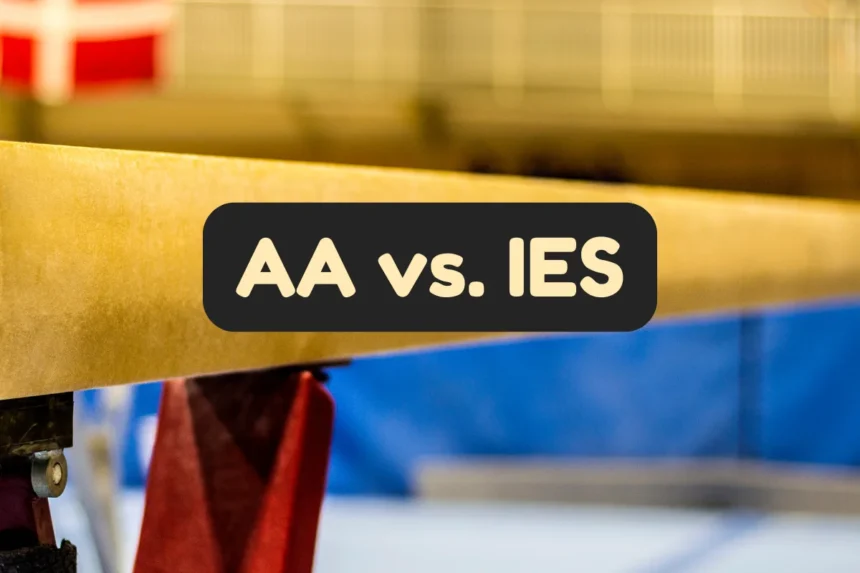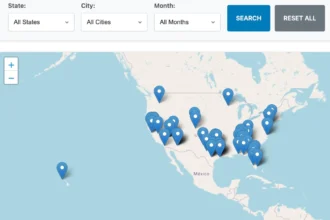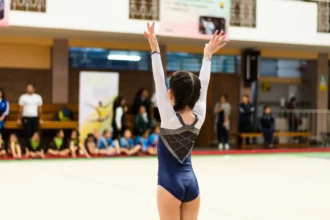In the optional levels of the USA Gymnastics Development Program, gymnasts no longer perform the same compulsory routines. Instead, they compete with optional routines that show both required skills and personal strengths.
To move up, they must earn mobility scores, set numbers that prove they’re ready for the next level. With this comes an important choice: follow the All-Around (AA) path or take the Individual Event Specialist (IES) path. Both can work, but each has its own advantages and limits.
Understanding Mobility in Optional Levels
At Levels 6–10, gymnasts must earn qualifying scores to advance. These mobility scores are set nationally in the Women’s Program Rules & Policies and apply across all states and regions.
- AA Path: Advancement is earned by achieving the required All-Around (AA) score at a sanctioned meet.
- IES Path: Advancement is earned by scoring 8.50 or higher on one or more individual events, regardless of the AA total.
⚠️ Important: IES scores are for mobility only. They do not qualify a gymnast to State, Regional, or National meets. For example, a gymnast cannot use an 8.50 IES on bars to qualify for Level 9 Easterns or Level 10 Nationals.
Verified Mobility Requirements by Level
USA Gymnastics sets national standards for moving through the optional levels. These requirements—spelled out in the Rules & Policies—ensure athletes only advance when they are ready for higher difficulty.
| Level | AA Mobility Requirement | IES Mobility Requirement | Key Notes |
|---|---|---|---|
| 6 → 7 | 32.00 AA | Not available | May be skipped if gymnast scored 32.00 AA at Level 5 |
| 7 → 8 | 32.00 AA | 8.50/event | First level where IES becomes an option |
| 8 → 9 | 34.00 AA | 8.50/event | IES works for mobility but not for Regionals/Nationals qualification |
| 9 → 10 | 34.00 AA | 8.50/event | Same IES limitation applies |
| 10 → Elite | None | None | Advancement requires Elite qualification through separate testing |
Key takeaway:
- The AA path is the standard route for most gymnasts, especially those aiming for postseason competitions.
- The IES path helps athletes move up a level, but at Levels 8–9 it does not guarantee Regional or National eligibility.
Level-by-Level Insight: AA vs. IES
Level 6
The first optional level and a shift away from compulsory routines. Skills are still relatively basic—giant swings, back tucks, and clean execution form the foundation.
- Mobility Requirement: 32.00 AA
- Skip Option: May skip Level 6 with 32.00 AA at Level 5
- IES: Not available
Level 7
Difficulty rises, with event-specific skills like a clear hip circle on bars or an aerial cartwheel on beam. Routines gain more variety and personality.
- Mobility Requirement: 32.00 AA
- IES Requirement: 8.50/event (first level offering IES)
Level 8
Gymnasts must now perform C-level skills such as release moves on bars, connected acro on beam, and advanced tumbling on floor. The jump in expectations is significant.
- Mobility Requirement: 34.00 AA
- IES Requirement: 8.50/event
- Note: IES moves a gymnast up but does not qualify them for Regionals/Nationals
Level 9
Routines begin to resemble elite-level gymnastics, with complex combinations, artistry, and high-value skills.
- Mobility Requirement: 34.00 AA
- IES Requirement: 8.50/event
- Note: Same limitation—IES is for mobility, not postseason competition
Level 10
The top of the Development Program. Gymnasts perform D/E-level skills, showcase advanced artistry, and polish their execution for college or Elite goals.
- Mobility Requirement: None
- Note: Advancement to Elite requires separate qualification scores
When to Choose the AA Path
The All-Around (AA) path is the most common and recommended route. Advancement requires 32.00 AA at Levels 6 and 7, and 34.00 AA at Levels 8 and 9. Level 10 has no mobility requirement.
Choose AA if:
- You are well-balanced across all four events, even if one is weaker.
- You want maximum competition exposure, including All-Around titles and team contributions.
- You’re aiming for college gymnastics, where versatility matters.
- You want long-term growth across all apparatuses.
In short, AA is best for gymnasts who want the full competition experience, versatility, and open opportunities for the future.
When to Choose the IES Path
The Individual Event Specialist (IES) path is for gymnasts who excel on one apparatus and want to advance without competing all four events.
Choose IES if:
- You have a standout event where you can consistently score 8.5+ (Levels 7–9).
- You’re recovering from injury and can’t train every event.
- You want to focus training on a specialty rather than spreading energy across all apparatuses.
- You need a strategic way to move up a level when your AA score falls short.
IES is a valuable tool for short-term advancement or specialization but should not be viewed as a substitute for the All-Around path, especially if postseason competition is a goal.
Common Myths (Busted)
“IES is only for injured athletes.”
❌ False. While often used during recovery, IES can also help athletes strong on one event but still developing another.
“You can’t switch back to AA.”
❌ False. Gymnasts can return to AA after competing IES if their state or region’s meet rules allow. Many athletes specialize briefly, then move back once they’re ready.
“IES means lower ceilings.”
❌ False. Advancement depends on execution, readiness, and smart routines—not the chosen path. IES is simply a tool, not a cap on potential.
Real-World Insight
Parents and coaches often point out that mobility scores don’t always equal true readiness:
“My daughter did Xcel Silver, then Gold, and scored out of Level 4. She was training Level 6 skills while still working Level 5 routines for mobility.”
“Skill-wise, Xcel Gold gave her a foundation for Level 6, but once we moved to a more competitive gym, it became clear she wasn’t quite ready. Mobility alone doesn’t equal readiness.”
These experiences show that moving up requires more than just numbers. Consistency, confidence, and overall development matter just as much as mobility scores.






